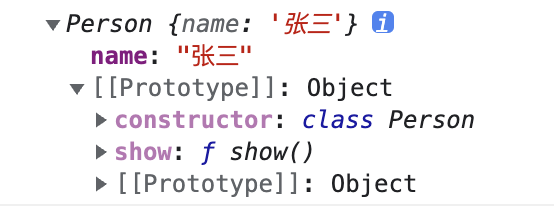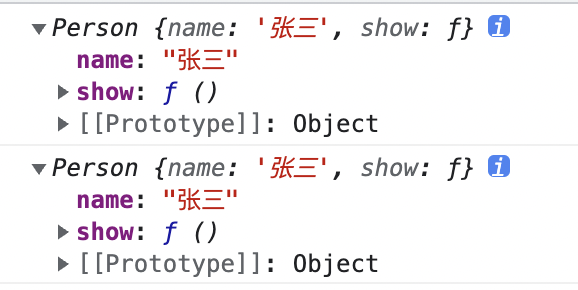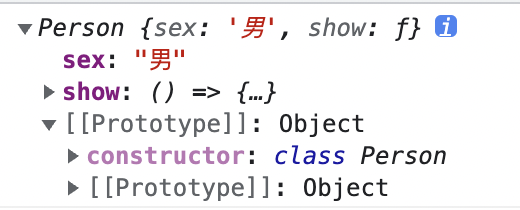一、Class 原型链与严格模式
1、Class 中的方法存于原型链,属性存于实例
方法存于原型链,但是只能通过实例去调用
- 错误写法
```css
class Person {
constructor(name) {
} show() {this.name = name;
} }console.log(this);
Person.show(); // Person.show is not a function
- 正确写法
```css
class Person {
constructor(name) {
this.name = name;
}
show() {
console.log(this);
}
}
let p = new Person("张三");
p.show();
结合 this 是谁调用它,它就指向谁,因此其输出结果如下
其 name 属性是 p 自带的,但方法其实是存放在原型链上
2、严格模式
严格模式:use strict,在该模式下,方法内的 this 不允许指向 window 对象(本来方法内的 this 都指向window)
"use strict"; (function() { console.log(this); // undefined })();非严格模式
(function() { console.log(this); // Window })();
3、Class 中函数自带严格模式
class Person {
constructor(name) {
this.name = name;
}
show() {
console.log(this);
}
}
let p = new Person("张三");
let c = p.show;
c();
上述代码相当于以下的写法
"use strict";
let c = function() {
console.log(this); // undefined
}
c();
显然, 输出为 undefined
二、解决 Class 函数中 This 异常
1、以 bind() 的方式
class Person {
constructor() {
this.show = this.show.bind(this);
}
show() {
console.log(this);
}
}
let p = new Person("张三");
p.show(); // 正常输出
let c = p.show;
c(); // 正常输出
- 输出结果如下

- 此时二者调用的 show 方法不再是原型链上的方法,而是自身的方法,因此 c 中输出的也是张三
- 加深理解,看以下代码
```css
class Person {
constructor(name) {
} show() {this.name = name; this.way = this.show.bind(this);
} }console.log(this);
let p = new Person(“张三”);
let c = p.show; c(); // undefined
let d = p.way; d(); // 正常输出
<a name="xkN9g"></a>
#### 2、以箭头函数的方式解决
- 常量可直接定义在构造函数外
```css
class Person {
constructor(name) {
this.name = name;
this.sex = "男";
}
}
let p = new Person("张三");
console.log(p);
- 上述代码可简写成如下
```css
class Person {
sex = “男”;
constructor(name) {
} }this.name = name;
let p = new Person(“张三”);
console.log(p);
- 其输出结果相同

- 箭头函数: 自身无 this, 若内部调用 this, 则寻找外层的 this
```css
class Person {
sex = "男"
show = () => {
console.log("show 方法执行, sex: " + this.sex);
}
}
let p = new Person();
let s = p.show;
s();
- 上述代码中, show() 不再存于原型链, 因为其采用的是 = 赋值的方式,凡事 = 赋值的都存于实例自身,打印实例p的结果如下

- 若采用 function 的方式, 则仍会报错,因为 function 中包含 this,不会去寻找 p 指向的 this
```css
class Person {
sex = “男”
show = function() {
} }console.log("show 方法执行, sex: " + this.sex);
let p = new Person(); let s = p.show; s(); // this is undefined ```

